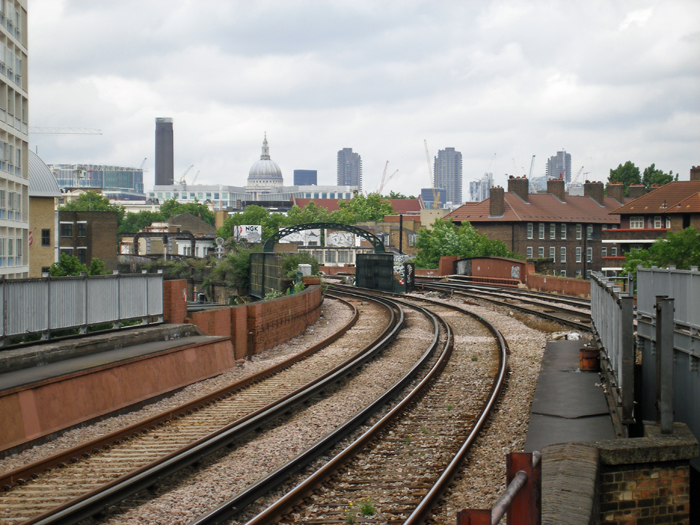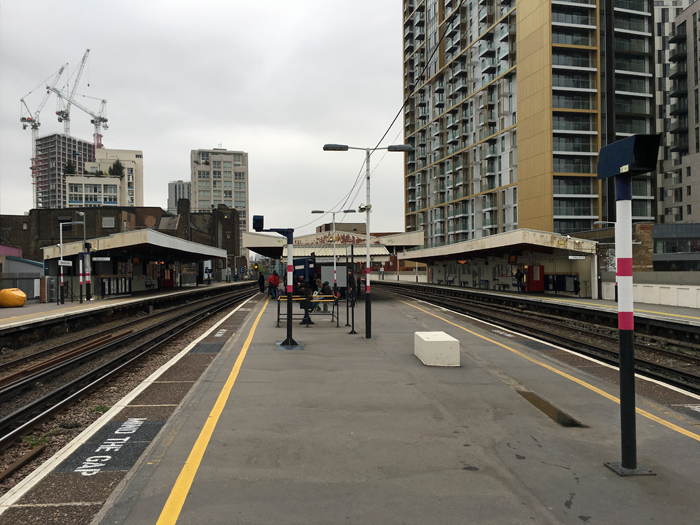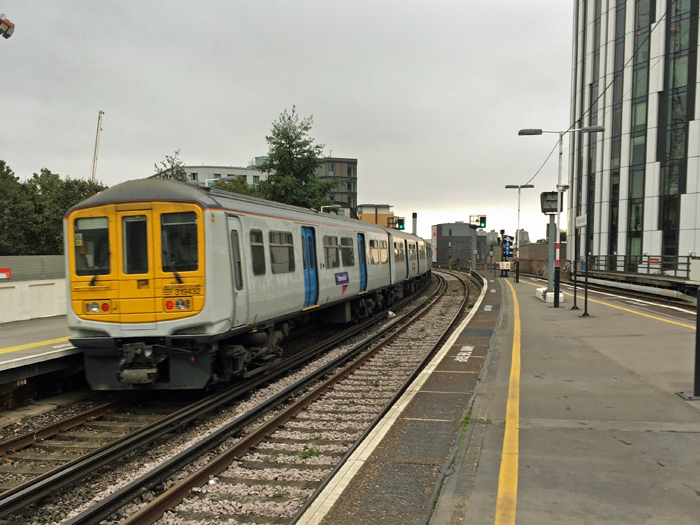
Strictly speaking, this station was not provided with any goods facilities, but to the north and south, Elephant & Castle was flanked by sizeable coal depots. Interestingly, neither of these belonged to the LC&DR, but were instead creations of the Great Northern (GNR) and Midland Railways (MR), both depots being commissioned in 1871. The depot to the north, on the "down" side of the line, was that of the GNR, and was afforded a single connection with the most eastern of the four running lines, on the throat of the station. The MR depot was further away, about 250-yards south, in Walworth, but had connections to both of the running lines of 1862. Perhaps these depots can be covered in their own dedicated sections on the website at some stage.
The mention of the coal depots is important because it sheds light on the financial history of the Metropolitan Extension's construction. Lacking the ability to raise finance for the scheme alone, the LC&DR sought capital from the GNR, MR, and LSWR, to complete the line. In return, these three companies were granted running powers, which eventually led to an interesting range of inter-company services that are a topic in themselves.
Unlike the LSWR and LB&SCR, the SE&CR lacked the finance to electrify its suburban lines, a task which was left to the Southern Railway. One of the earliest ex-SE&CR routes to be electrified with 660-volts DC third rail was that from Holborn Viaduct to Orpington, via Herne Hill, including the line between the latter and Victoria. Public electric services commenced on 12th July 1925 and, on 21st March of the following year, four-aspect colour lights replaced semaphore signals between Holborn Viaduct and Elephant & Castle. These signals were jointly controlled by the signal box at Holborn Viaduct and a new cabin at Blackfriars Junction, south of the river. The signal box at Elephant & Castle was retained to control the "down" starter signals at the station, which were still semaphores. It was probably at this time that the SR applied its trademark "Target" name signs at Elephant & Castle, in addition to hexagonal lampshades, but other than these detail differences, this remained very much a LC&DR station in character.
Elephant & Castle suffered heavily during World War II, notably on the night of 10th/11th May 1941. Platforms 2 and 3, which formed the central island, were struck and, upon them, the trainshed of 1862 and signal box were burnt out. The canopy on platform 1, on the station's western side, was also destroyed and, on the eastern side of the station, the LC&DR wall of 1862 had large chunks blown out. Thereafter, control of the "down" starting semaphores at the station was assumed by the signal box at Walworth Coal sidings.
On 1st January 1948, British Railways came into existence and, in March of that year, repairs to the bomb-damaged station at Elephant & Castle were undertaken. Included was the provision of new canopies on all platform surfaces, these being 120-feet in length and comprising plain riveted-metal valances. The platforms were rebuilt using prefabricated concrete and the holes in the eastern wall of 1862 were infilled. SR-style "Target" name signs and hexagonal lampshades were, however, retained.
In 1961, the land on the station's western side was earmarked to be redeveloped into a huge shopping centre. The scheme was priced at £2,000,000 (£40,150,000 at 2015 prices) and included the construction of an 11-storey office block. The land was mostly that of a World War II bomb site, and the complex opened in May 1965. The project included making a hole in the western wall of the railway station and installing a footbridge to provide a direct link with the shopping centre.
Elephant & Castle retained its "down" semaphore starter signals until 1970 when, on 21st February of that year, three-aspect colour lights were introduced between there and Herne Hill. Signal boxes were still in use at neighbouring Loughborough Junction and Blackfriars (South Bank of the Thames); these closed on 29th November 1981 and 14th February 1982 respectively, when the Victoria Panel at Clapham Junction took control of the area.

A northward view from the end of platform 2 has the top of St Paul's Cathedral's dome on the horizon. Note the different design of bridge spans for each pair of tracks (1862 and 1866 tracks on the right and left respectively). Blackfriars Junction, where the double-track spur from the London Bridge to Charing Cross route joins the line, is ¾-mile distant, whilst Blackfriars station was ⅓-mile further on. © David Glasspool

Now in 2016, the skyline shows its endless evolution, gigantic new developments having appeared on the station's eastern side. The colour scheme was that of former franchise "First Capital Connect". © David Glasspool

"Thameslink" services along the route commenced in May 1988, which provided direct trains between Bedford and Brighton, Luton and Purley, and Cricklewood and Sevenoaks. At the time of this photograph, the Class 319 units - which had originally been built for the scheme - were being replaced on the route by Class 377 "Electrostars". © David Glasspool
Return to the Kent Rail Homepage or alternatively, check for Updates.
Website & Copyright information - Links - Contact the Webmaster